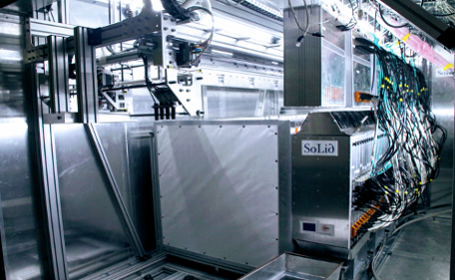
2017-12-21
|
A consortium of Belgian, British and French scientists has deployed a new kind of neutrino detector at the BR2 research reactor of SCK•CEN in Mol. After the discovery of the Higgs boson, the researchers are getting closer to achieve one of the biggest challenges in Science: detecting a new kind of elementary particle, the sterile neutrino. |
||
|
A consortium of Belgian, British and French Institutes as well as the Belgian federal nuclear laboratory SCK•CEN have been joining forces since early 2013 to develop a novel detector technology aimed at detecting neutrinos close to nuclear reactors. This ambitious project called SoLid (“Search for oscillation with a Lithium-6 detector”) tries to answer a fundamental question in the field of particle physics which has been fueling the debate between scientists for years: do sterile neutrinos exist? Detecting the intangible “All the particles we observed in the last four decades have been predicted by our theory. This success culminated with the discovery of the Higgs-Englert-Brout boson in 2012. A new type of neutrino would deeply change our vision of the universe and could give us a clue to what dark matter is.” says Antonin Vacheret, spokesperson of SoLid. Sterile neutrinos are even more elusive than neutrinos as they do not interact with matter and are therefore impossible to detect directly with current technologies. The experiment instead looks for indirect signs that would indicate the presence of the particle via a phenomenon called neutrino oscillations. “It is a bit like looking at ripples on your bed to figure out if something is hidden under the blanket. You cannot see what it is but you see the effect of it being there. That is what we will do with reactor neutrinos”, says Benoît Guillon who coordinates the analysis. |
 van links naar rechts: Bernard Coupé, Jeroen Mermans, Lars Ghys, Nick van Remortel, Maja Verstraeten, Yamiel Abreu Alfonso |
|
 |
Breakthrough technology Researchers have now built a novel type of antineutrino detector weighing more than 1,5 tons, based on small scintillating cubes to locate neutrinos stopping in the detector. The whole detector acts as a 3D camera recording neutrino signals with unprecedented resolution. In the past months the consortium has made a huge effort to assemble the 12 000 parts of the detector and tested the 3500 photon detectors that will “see” the tiny flashes of light produced by neutrinos in the detector. The consortium also designed and built a calibration robot which provides reference signals to monitor various regions of the detector and its response to neutrinos. After three years of intense research and development, the neutrino detector has been deployed at the BR2 research reactor at SCK•CEN in Mol. The reactor, which is responsible for the global production of medical radioisotopes used for imaging and cancer therapy, is also an ideal place to carry out fundamental research in the field of elementary particles. “The BR2 reactor environment is key, it turns out that it is one of the quietest places on earth to do this experiment.” explains Nick Van Remortel, technical coordinator and professor at the University of Antwerp. “It operates at around 60 MW of thermal power and the close stand-off provides ideal conditions for detecting sterile neutrinos.” SoLid researchers aim to provide a first answer to the question within a year and to make significant progress in the quest to find sterile neutrinos, a goal chased by many international consortia. “We are proud to contribute, thanks to our BR2 facility – which is unique in this context – and to our knowledge and know-how, to the success of this amazing project”, claims Steven Van Dyck, BR2 manager. “This project shows that our research facilities and know-how can compete with the best research institutes in the world.” |
|
This article has been reproduced from the original on the SCK-CEN website.
